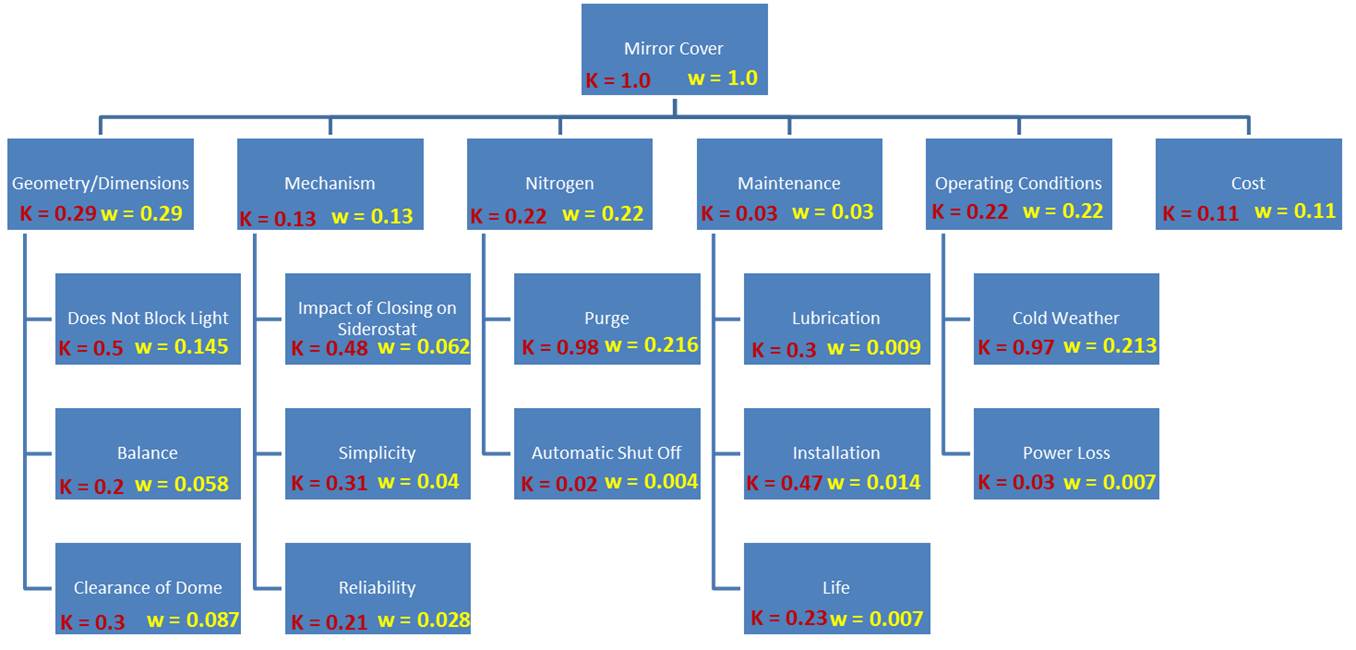Concept Selection
Criteria Tree
In order to assess the viability of each concept, the objectives and constraints for the project were evaluated thoroughly. Each criterion was broken down into specific descriptors that are applied to each concept.
- Geometry/Dimensions
- Mechanism
- Nitrogen
- Maintenance
- Operating Conditions
- Cost
The geometry of the mirror cover is the most important category for this project. The cover must fit into each siderostat housing without obstructing the dome or movement of the siderostat. Also, the cover must not block any star light from being collected by the mirror. The third consideration for the geometry is balance. The Siderostat is a precision instrument that is balanced in order to be able to make minute angle adjustments. Our cover must not disrupt the overall balance of the mirror. In order to accomplish this, there are adjustable tungsten counterweights that will be moved to counteract the mass of the cover.
The mechanism is broken down into three categories. The most important consideration is the impact that the mechanism will have on the siderostat during opening and closing. In order to maintain the alignment of the siderostat, little to no shock or abrupt force should be applied to the housing during opening or closing. Simplicity and Reliability are also considered for the mechanism.
The nitrogen system is a vital component for the life span of each mirror. During storage, moisture contained in the atmospheric air condenses on the mirror causing corrosion. To counteract this, a steady stream of nitrogen is injected into the mirror cover, displacing atmospheric air and vapor. The current system does not employ a shut off valve for the nitrogen when the cover is open. In order to conserve nitrogen and reduce operating costs for the facility, we will investigate the possibility of having an automated valve to turn off the nitrogen flow while the cover is open.
The maintenance was a small portion of the overall design considerations. The life and ease of installation are directly related. If a solution allows for increased life but difficult installation, the benefit of the long life will outweigh the inconvenience of an extended installation time. The opposite is also true, a concept with a relatively short life could still be considered if replacement is simple.
The cost of each concept was also considered. Due to the expense of the components the cover will be protecting, a higher cost is permitted granted the design achieves higher levels of protection. This is also a government funded project, allowing further lenience over the budget.

Decision Matrix
Using the weighted values in the criteria tree, a decision matrix is created for each of the concepts. A rating from one to nine is given based on competency for each category. The values are then multiplied by their respective weights and summed to give a weighted score to each concept. In the matrix shown, the top four concepts are compared.
